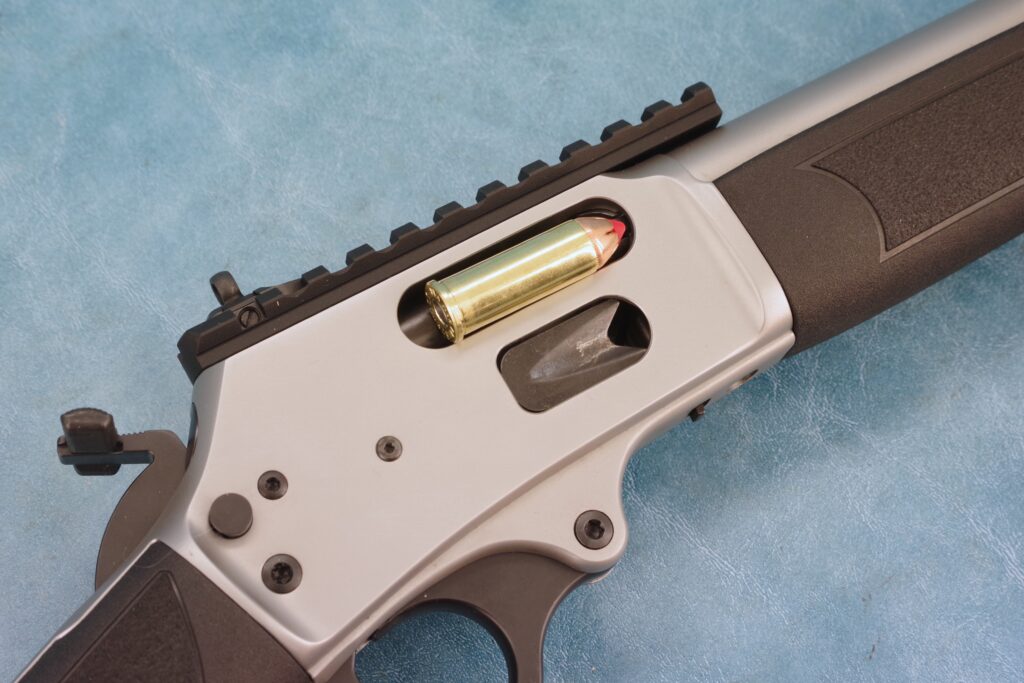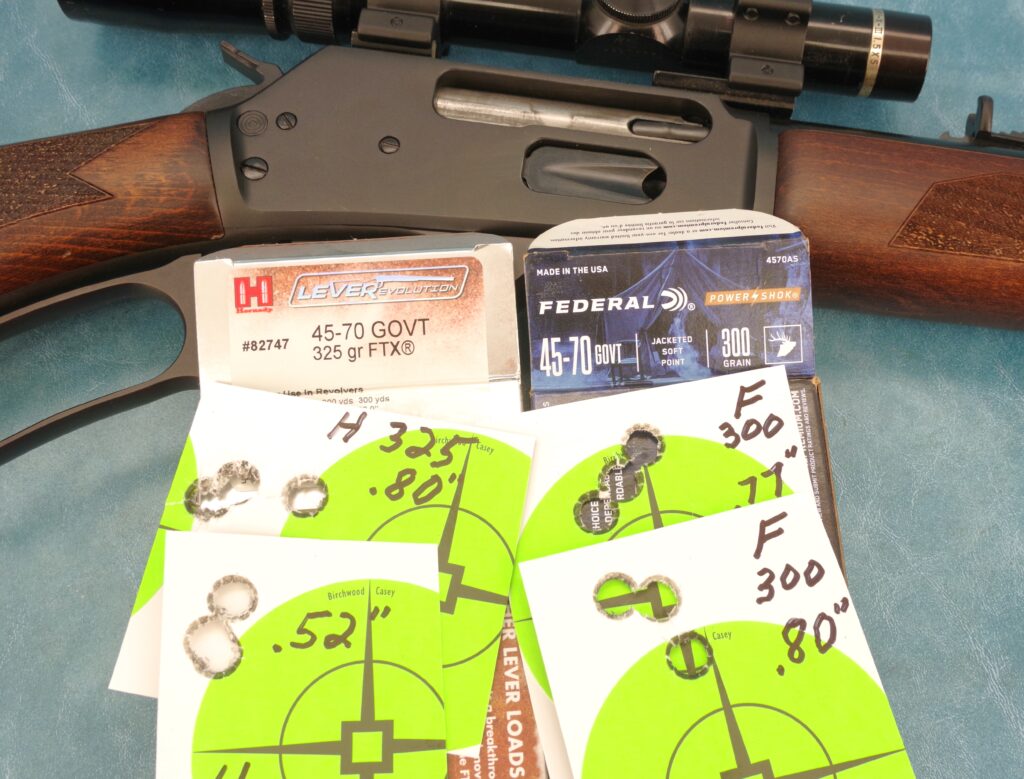Rossi, Smith & Wesson Leverage History
By Jon R. Sundra
Originally published in the September/October 2024 Issue of Safari Magazine.
In case you haven’t noticed, there’s been a lot of interest lately in the traditional lever-action rifle. By “traditional,” I mean the slab-sided, tubular-fed carbines epitomized by the iconic Winchester 94 and Marlin 336.
WHAT HAS CHANGED?
Well, it started in 2014 when Michigan’s game department made some straight-walled cartridges legal for deer hunting, where, until then, only shotguns were allowed. Suddenly, cartridges like the .450 Bushmaster in the AR platform and lever actions chambered in .44 Rem. Magnum, .444 Marlin, .450 Marlin and .45-70 were in demand.
Since then, four other states — Iowa, Ohio, Indiana and Illinois — have passed similar legislation allowing the use of some straight-walled cartridges for deer hunting either statewide or within certain designated areas and seasons. Of the 14.3 million licensed hunters in the United States, nearly six million live in these five states, so you can imagine how much of an impact this has had on gun and ammunition manufacturers, let alone those millions of hunters previously saddled with the limited range and accuracy of shotgun slugs.
The original rationale for shotgun-only laws was that slugs and buckshot had limited range and power and were, therefore, considered relatively safe in more densely populated hunting areas. Using that criterion, these five states decided to give a second look at what cartridges could be considered relatively safe in terms of limited range.
Without going too deep into the weeds here, it suffices to say that as long as there are limits as to maximum case length — and there are — there are intrinsic limitations to straight-walled cartridges. Considerations such as case capacity, especially in .40 to .50 calibers, impose practical limits as to bullet shape, length, weight and diameter (caliber).
It must be noted that Hornady’s introduction of the Flex Tip FTX bullet helped revive the traditional lever action by allowing spitzer-type bullets to be used in tubular magazines. “Revolutionary” is not too strong a word to describe the impact FTX has had on rounds like the .30-30, .32 Win. Special, .35 Rem. and 348 Win., for it nearly doubles the effective range of these grand old cartridges. With straight-wall cases, the results aren’t quite as dramatic, but Flex Tip technology significantly stretches the effective range of these cartridges.
Regulations as to case length and caliber vary widely from state to state to the point where some even allow the thumping .45-70 and high-intensity bottleneck cartridges like the .243 and .308 Win. Suffice to say that if you have any questions as to what’s legal in your state, be sure to go online and check.
During the four years that the other states followed Michigan’s lead in the straight-wall movement, sales of Winchester, Ruger (nee Marlin), Rossi, Uberti, Henry, and Smith & Wesson lever action rifles, as well as AR platform guns, have surged. Adding impetus was Winchester’s introduction of its .350 Legend in 2019. My first impression of the Legend cartridge was, Why? Why introduce a cartridge that virtually duplicated the ballistics of the 116-year-old .35 Remington? Knowing what I know now, I think Winchester made quite an astute move. What they did was design a cartridge that was compliant with all regs of the straight-wall states and equally at home in MSRs and bolt actions. Unfortunately, the .350 (and the .400 Legend that debuted in 2023) are not offered in traditional level actions because they are based on rimless cases, which are problematic for that rifle type.
So now that we’re up to speed, let’s take a look at the newest additions to the classic lever action lineup: Smith & Wesson’s Model 1854 chambered in .44 Rem. Magnum and Rossi’s R-95 in .45-70 Gov’t.
SMITH & WESSON MODEL 1854

A lot of people did a double take when they first heard about a lever action from a company whose name has always been synonymous with handguns. How they came up with the Model 1854 designation was a bit of a stretch, but that year, Smith & Wesson introduced the .41 Volcanic, a toggle-joint lever action repeating pistol. Shortly after that, the patents were sold to Oliver Winchester.
Such was Smith & Wesson’s first and only connection to a lever action rifle for the next 170 years!
The 1854 is an entirely new rifle offering some really neat features, but it is essentially a smaller version of the Marlin 336 in both design and mechanics. The forged 416 stainless receiver, which, by the way, is beautifully machined and finished, is one inch shorter than that of the 336, resulting in a bolt travel that’s also an inch shorter, even though the lever arc is virtually the same as the Marlin’s. The ejection port, too, is smaller, just large enough to accommodate the .44 Magnum cartridge.
To me, the neatest feature of this carbine is its 9-round under-barrel tubular magazine. All other centerfire lever actions require that the action be cycled to extract and eject each live round from the magazine — a lengthy and clumsy procedure because it requires one hand to hold the gun and the other to work the lever. The result is rounds being tossed onto grass, snow or dirt. Not so with the 1854. Its magazine is like those found on .22 rimfire rifles — the magazine tube pulls free. Tipping the muzzle downwards, gravity empties the magazine into one’s awaiting hand.

Our test gun was the synthetic stock variant. It has three M-Lok slots at the 3, 6 and 9 o’clock positions on the fore-end to facilitate mounting lights, lasers, bipods or an alternate sling attachment (the Walnut stock version has no M-Lok slots). The 19 1/4-inch barrel is 410 stainless with a 1:20 twist and an 11/16×24 threaded muzzle for brake or can installation. On the receiver is an 11-slot picky rail with a ghost aperture sight in conjunction with a gold bead front. Having had Lasik surgery, my right eye is my distance eye, so I can’t use open sights. But with an aperture, however, I can. The rail gives the option of mounting a scope or red dot sight, so all the aiming options are covered. I just wish the rail extended further out over the barrel to allow a more forward scope positioning.
As for the mechanics, I’m sure you’re all familiar with them. The exposed hammer (for which an ambidextrous extension is supplied) has the traditional half and full-cock positions working in conjunction with a cross-bolt safety. As a further safety feature, the lever must be fully closed against the tang so that the gun can fire. The flat-face trigger is unique among guns of this type, but I prefer the old-fashioned curved face. As previously noted, the receiver, as well as the barrel and magazine tube, sport a very attractive matte stainless finish. Our test gun has an MSRP of $1,279; the Walnut-stocked version is $1,399.
ROSSI R-95

Turning to the Rossi R-95, if you’re familiar with the Marlin 336 (or 1895), you know this gun. For years, Rossi made traditional lever actions chambered in pistol calibers based on clones of the flat bolt, split receiver Marlin 1894. However, this Brazilian-made gun is a virtual copy of the 336, except for a couple of features. One is that the firing pin is a one rather than two-piece affair; this can be seen at the rear of the bolt when it’s open. Also, the extractor has been changed to a pivoting lever that is very similar to that of an AR-15. Technically, both changes could be considered improvements. Other than that, we’re looking at a 336 clone.
The R-95 is offered in three barrel lengths. The Trapper model sports a 16-1/2-inch spout and has a threaded muzzle; the 20- and 22-inch barreled variants do not. The Trapper’s magazine holds five rounds, while the 20- and 22-inch barrel variants hold six. The barrel and magazine tube on all three models are nicely blued to a medium sheen that contrasts with the matte finish of the lever and receiver. The grip panels on the hardwood buttstock and fore-end stock are stippled but only marginally effective. The MSRP for the R-95, as tested, is $1,060.99.
AT THE RANGE
On the range, both guns performed as expected; that is, there were no malfunctions of any kind. Like all exposed hammer guns, the triggers were not up to bolt action standards and there was quite a bit of creep before the 1854’s broke at five pounds, the Rossi at 4 1/2. Lever actions have never been known for gilt-edge accuracy, but both guns had more than enough for distances well beyond the effective ranges of the calibers in question.

The R-95 was the more accurate of the two, with one group measuring 1/2 inch, but the overall average was about 1.1 inches for the three loads tested and 1.4 for the four loads put through the 1854. All shooting was from the bench at 50 yards using premium-grade ammo from Hornady and Federal.
What really impressed me was the dramatic increase in the performance of the .44 Magnum in the 19 1/4 barrel of the Model 1854. With Hornady’s 225-grain FTX load, you can expect 1,800 fps, which is 390 fps faster than when fired from a 7 ½ -inch barreled revolver. As to what that does for trajectory and retained energy, here’s what they look like based on a 100-yard zero.
RANGE (YDS) VELOCITY (FPS) ENERGY (FT. LBS) TRAJECTORY(INCHES)
0 1800 1620 -1.5
50 1575 1240 1.0
100 1375 945 0.0
150 1210 735 -5.6
To put that into perspective, no one would deny that from a handgun at 50 yards, the .44 Mag is deadly on any deer-size critter. At that distance, the Hornady FTX load delivers 760 ft. lbs. of energy. That same load out of S&W’s Model 1854 is packing 725 ft. lbs. at 150 yards!
NEW OPPORTUNITY
Millions of hunters who once had to live with the limitations of slug-stoked shotguns have now been given a more level playing field.
It doesn’t give them the flat-shooting, long-range potential enjoyed by those hunters living in the states where magnums are allowed, but in many cases, it almost doubles the effective ranges they once had to live with.
As for these two newest additions to the classic lever action lineup, both exemplify why this uniquely American rifle type has survived and prospered for more than 150 years.
Jon R. Sundra, Safari Magazine’s Field Editor, has been a professional firearms writer for more than 50 years. Reach him at [email protected].

